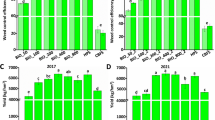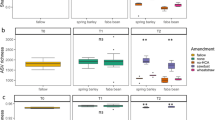Abstract
There is increasing interest in good agriculture practices that address the issues of sustainability, reduction in inputs such as fertilizers and pesticides while maintaining crop yield and soil fertility. It is important that soil microbial diversity and function are not impaired by altered agricultural practice. In this study, as indicators of soil quality, the bacterial community structure was evaluated from a long-term field trial managed with conventional and low-input fertilization/pesticide regimes. The low-input plots under study received approximately one fifth less N fertilizer than the conventional-input plots, a maximum of half the recommended application rates of fungicides and pesticides and no externally added P source. A non-culturable approach was taken using polymerase chain reaction–denaturing gradient gel electrophoresis analysis of 16S rRNA and alkaline phosphomonoesterase [phosphatase] (ALP) genes in an attempt to relate bacterial community structure to respective field management regimes. To identify the ALP bacteria in these plots, randomly selected ALP clones were sequenced. The results based on Shannon diversity indices and community structure analysis of ALP genes suggest differences in community diversity and structure under conventional and low-input barley sites in most sampling seasons. We conclude that soil fertilization management affects the ALP bacteria in the barley rhizosphere, while the overall changes in bacterial community in these sites are prominently due to seasonal variation compared to crop or input regimes. The randomly selected ALP sequences identified from these sites were mostly from the Alpha and Gamma classes of Proteobacteria.




Similar content being viewed by others
Reference
Barret M, Morrissey JP, O’Gara F (2011) Functional genomics analysis of plant growth-promoting rhizobacterial traits involved in rhizosphere competence. Biol Fertil Soils 47:729–743
Beauregard MS, Hamel C, Atul-Nayyar St-Arnaud M (2010) Long-term phosphorus fertilization impacts soil fungal and bacterial diversity but not AM fungal community in alfalfa. Microb Ecol 59:379–389
Benson DA, Karsch-Mizrachi I, Lipman DJ, Ostell J, Wheeler DL (2008) GenBank. Nucleic Acids Res 36:25–30
Bloem J, Deruiter PC, Koopman GJ, Lebbink G, Brussaard L (1992) Microbial numbers and activity in dried and rewetted arable soil under integrated and conventional management. Soil Biol Biochem 24:655–665
Bossio DA, Scow KM, Gunapala N, Graham KJ (1998a) Impacts of carbon and flooding on soil microbial communities: phospholipid fatty acid profiles and substrate utilization patterns. Microb Ecol 35:265–278
Bossio DA, Scow KM, Gunapala N, Graham KJ (1998b) Determinants of soil microbial communities: effects of agricultural management season and soil type on phospholipid fatty acid profiles. Microb Ecol 36:1–12
Bossio DA, Girvan MS, Verchot L, Bullimore J, Borelli T, Albrecht A, Scow KM, Ball AS, Pretty JN, Osborn AM (2005) Soil microbial community response to land use change in an agricultural landscape of western Kenya. Microb Ecol 49:50–62
Browne P, Rice O, Miller SH, Burke J, Dowling DN, Morrissey JP, O’Gara F (2009) Superior inorganic phosphate solubilization is linked to phylogeny within the Pseudomonas fluorescens complex. Appl Soil Ecol 43:131–138
Byrne E (1979) Chemical analysis of agricultural materials. An Foras Taluntais Dublin
Clegg CD, Lovell RD, Hobbs PJ (2003) The impact of grassland management regime on the community structure of selected bacterial groups in soils. FEMS Microbiol Ecol 43:263–270
Conry MJ, Hogan JJ (2001) Comparison of cereals grown under high (conventional) and low (reduced) input systems. Teagasc Crops Research Centre Oak Park Carlow ISBN: 1841702102
Diepeningen AD, van Vos OJ, de Korthals GW, van Bruggen AHC (2006) Effects of organic versus conventional management on chemical and biological parameters in agricultural soils. Appl Soil Ecol 31:120–135
European Commission Communication of 16 April from the Commission to the Council TEP the Economic and Social Committee and the Committee of the Regions: towards a thematic strategy for soil protection (2002) [Com (2002) 179 Final]
Fay, D. Zhang, C (2012) “Towards a National Soil Database”. Datasets Available At: Secure Archive For Environmental Research Data managed by Environmental Protection Agency Ireland http://erc.epa.ie/safer/resource?id=c265bb3f-2cec-102a-b1da-b128b41032cc (Last Accessed: 2012-03-06)
Garbeva P, van Veen JA, van Elsas JD (2004) Microbial diversity in soil: selection microbial populations by plant and soil type and implications for disease suppressiveness. Annu Rev Phytopathol 42:243–70
Germaine KJ, Chhabra S, Song B, Brazil D, Dowling DN (2010) Microbes and sustainable production of biofuel crops: a nitrogen perspective. Biofuels 1(6):877–888
Girvan MS, Bullimore J, Pretty JN, Osborn AM, Ball AS (2003) Soil type is the primary determinant of the composition of the total and active bacterial communities in arable soils. Appl Environ Microbiol 69(3):1800–1809
Girvan MS, Bullimore J, Ball AS, Pretty JN, Osborn AM (2004) Responses of active bacterial and fungal communities in soils under winter wheat to different fertilizer and pesticide regimens. Appl Environ Microbiol 70:2692–2701
Gunapala N, Scow KM (1998) Dynamics of soil microbial biomass and activity in conventional and organic farming systems. Soil Biol Biochem 23:507–513
Heuer H, Krsek M, Baker P, Smalla K, Wellington EM (1997) Analysis of actinomycete communities by specific amplification of genes encoding 16S rRNA and gel electrophoretic separation in denaturing gradients. Appl Environ Microbiol 63:3233–3241
Kruskal JB (1964) Nonmetric multidimensional scaling: a numerical method. Psychometrika 29:115–129
Nannipieri P, Giagnoni L, Landi L, Renella G (2011) Role of phosphatase enzymes in soil. In Bunemann EK et al (Eds) Phosphorus in action. Soil Biology 26 Springer Verlag, Berlin Heidelberg. Pp 215-241
O'Donnell AG, Seasman M, Macrae A, Waite I, Davies JT (2001) Plants and fertilisers as drivers of change in microbial community structure and function in soils. Plant Soil 232:135–145
Peacock AD, Mullen MD, Ringelberg DB, Tyler DD, Hedrick DB, Gale PM, White DC (2001) Soil microbial community responses to dairy manure or ammonium nitrate applications. Soil Biol Biochem 33:1011–1019
Poole K, Hancock REW (1983) Secretion of ALP and phospholipase C in Pseudomonas aeruginosa is specific and does not involve an increase in outer membrane permeability. FEMS Microbiol Lett 16:25–29
Reganold JP, Jackson-Smith D, Batie SS, Harwood RR, Kornegay JL, Bucks D, Flora JC, Hanson CB, Jury WA, Meyer D, Schumacher A Jr, Sehmsdorf H, Shennan C, Thrupp LA, Willis P (2011) Transforming U.S. Agriculture. Science 332:670–671
Renella G, Landi L, Ascher MT, Ceccherini G, Pietramellara G, Nannipieri P (2006) Phosphomonoesterase production and persistence and composition of bacterial communities during plant material decomposition in soils with different pH values. Soil Biol Biochem 38:795–802
Renella G, Landi L, Garcia Mina JM, Giagnoni L, Nannipieri P (2011) Microbial and hydrolase activity after release of indoleacetic acid and ethylene-polyamine precursors by a model root surface. Appl Soil Ecol 47:106–110
Roder W, Mason SC, Clegg MD, Doran JW, Kniep KR (1988) Plant and microbial responses to sorghum-soybean cropping systems and fertility management. Soil Sci Soc Am J 52:1337–1342
Rodriguez H, Fraga R (1999) Phosphate solubilizing bacteria and their role in plant growth promotion. Biotechnol Adv 17:319–339
Saitou N, Nei M (1987) The neighbor-joining method: a new method for reconstructing phylogenetic trees. Mol Biol Evol 4:406–425
Sakurai M, Wasaki J, Tomizawa Y, Shinano T, Osaki M (2008) Analysis of bacterial communities on ALP genes in soil supplied with organic matter. Soil Sci Plant Nutr 54:62–71
Sarathchandra S, Perrott K, Boase W, Je W (1988) Seasonal changes and the effects of fertiliser on some chemical biochemical and microbiological characteristics of high-producing pastoral soil. Biol Fertil Soils 6:328–335
Shannon CE, Weaver W (1949) The mathematical theory of communication. The University of Illinois Press, Urbana
Smart J, Dilworth MJ, Robson AD (1984) Effect of phosphorus supply on phosphate uptake and alkaline phosphatase activity in Rhizobia. Arch Microbiol 140:281–286
Stewart WD (1991) The importance to sustainable agriculture of biodiversity among invertebrates and microorganisms. In: Hawksworth DL (ed) The biodiversity of microorganisms and invertebrates: its role in sustainable agriculture, 1st edn. CABI, UK, pp 3–6
Sun HY, Deng SP, Raun WR (2004) Bacterial community structure and diversity in a century-old manure treated agroecosystem. Appl Environ Microbiol 70:5868–5874
Tamura K, Dudley J, Nei M, Kumar S (2007) MEGA4: molecular mvolutionary genetics snalysis (MEGA) software version 4.0. Mol Biol Evol 24:1596–1599
Toljander JF, Santos-Gonzalez JC, Tehler A, Finlar RD (2008) Community analysis of arbuscular mycorrhizal fungi and bacteria in the maize mycorrhizosphere in a long-term fertilization trial. FEMS Microbiol Ecol 65:323–338
Tomasi N, Weisskopf L, Renella G, Landi L, Pinton R, Varanini Z, Nannipieri P, Torrent J, Martinoia E, Cesco S (2008) Flavanoids of white lupin roots participate in phosphorus mobilisation from soil. Soil Biol Biochem 40:1971–1974
Torriana-Gorini A, Rothman FG, Silver S, Wright A, Yagil E (1987) Phosphate metabolism and cellular regulation in microorganisms. American Society for Microbiology, Washington DC
Torsvik V, Sørheim R, Goksøyr J (1996) Total bacterial diversity in soil and sediment communities—a review. J Ind Microbiol 17:170–178
Vershinina OA, Znamenskaia LV (2002) The Pho regulons of bacteria. Microbiology 71:497–511
Weisberg WG, Barns SM, Pelletier DA, Lane DJ (1991) 16S ribosomal DNA amplification for phylogenetic study. J Bacteriol 173:697–703
Wijnands FG, Vereijken PH (1992) Region-wise development of prototypes of integrated arable farming and outdoor horticulture. Neth J Agric Sci 225-238
Wu T, Chellemi DO, Graham JH, Martin KJ, Rosskopf EN (2008) Comparison of soil bacterial communities under diverse agricultural land management and crop production practices. Microb Ecol 55:293–310
Acknowledgments
This research was supported in part by grants awarded by the Department of Agriculture and Food stimulus 2 programmes, Ireland; TSRIII ‘Agribiotics’ Project, Higher Education Authority, Ireland, SFI TIDA, and SC is the holder of a Teagasc Walsh Fellowship, Ireland.
Author information
Authors and Affiliations
Corresponding author
Rights and permissions
About this article
Cite this article
Chhabra, S., Brazil, D., Morrissey, J. et al. Fertilization management affects the alkaline phosphatase bacterial community in barley rhizosphere soil. Biol Fertil Soils 49, 31–39 (2013). https://doi.org/10.1007/s00374-012-0693-2
Received:
Revised:
Accepted:
Published:
Issue Date:
DOI: https://doi.org/10.1007/s00374-012-0693-2




